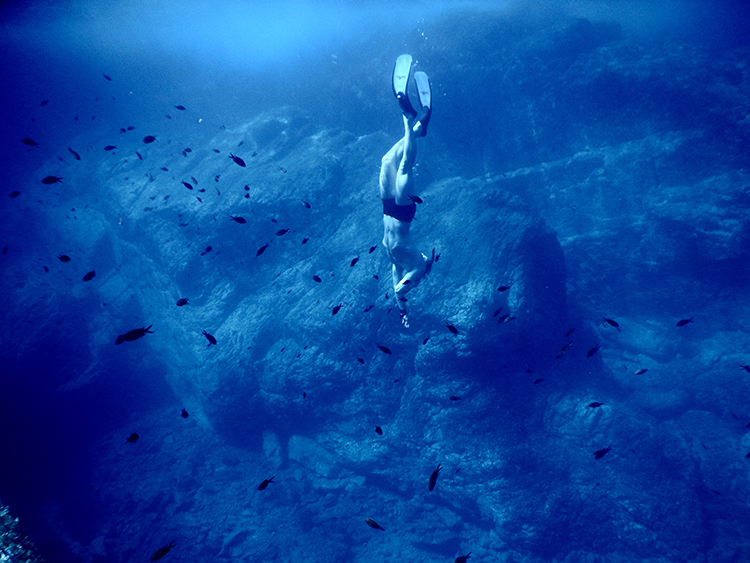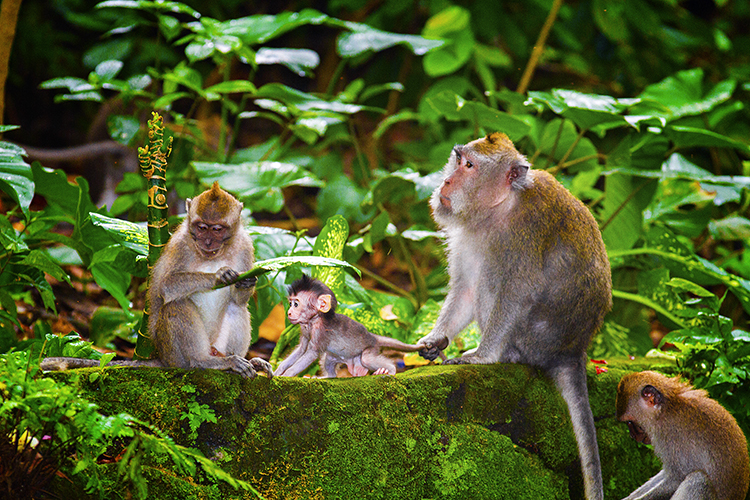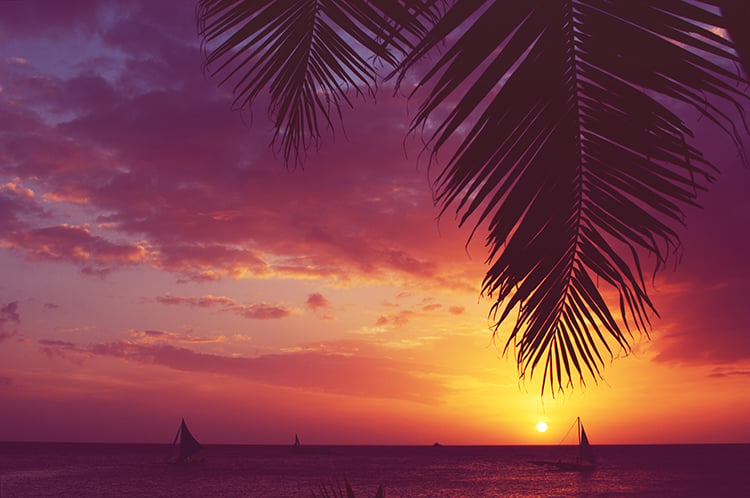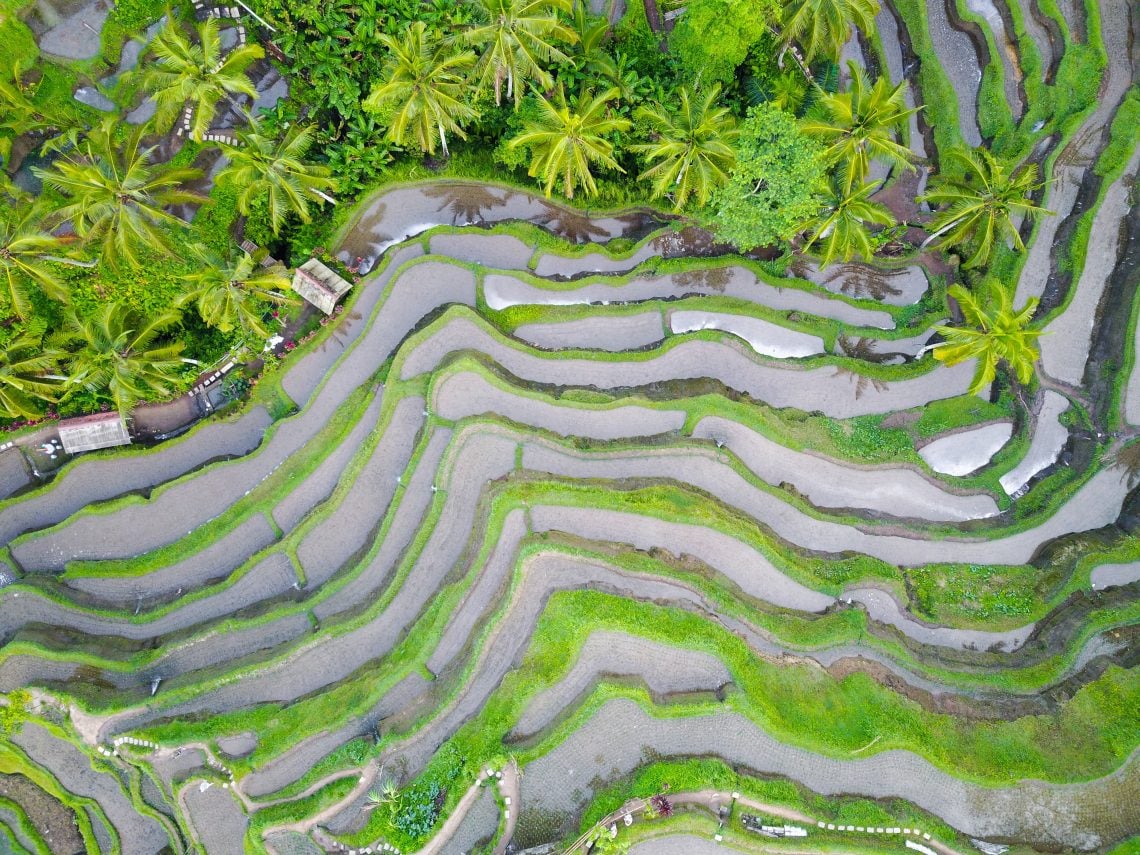Wondering when’s the best time to visit Bali? It all depends on what you’re after. Go in the dry season and the island will be at its busiest and best. Visit off peak and you’ll avoid the crowds and hiked up prices.
Whether you’re planning a fun-filled family vacation or a romantic getaway for two, check out this handy month-by-month guide to help you plan your trip.
Bali basically has 2 seasons, dry and rainy. Even so, it’s usually warm and humid throughout the year with temperatures ranging between 78-86F. Predicting the weather can be hard, especially in the tropics (Bali is just 8 degrees south of the equator) but you’ll typically get hot sun and rain showers between October and March, and dry weather spanning between April and September.
The good news about visiting Bali in the wet season is that it doesn’t rain all day every day. You can still sunbathe and sightsee, and the wetter weather really enhances Bali’s lush green landscape. The rainy season is a great time to go to avoid the crowds and traffic, especially if you’re visiting the island’s more touristy spots. It’s also a good time price-wise as the rates drop for accommodation and airline tickets.
Going towards the end of the wet season, just before the dry season starts (known as the shoulder season) is a good time to go if you want the best of both worlds. The prices are still lower but it rains less so you can take advantage of everything the island has to offer.
Many visitors find that April, May, June and September are the best times to visit Bali, when the weather is warm and sunny but there are fewer crowds in popular tourist resorts like Kuta and Seminyak.
Month-by-month guide
January
Although January is considered a ‘cold’ month, the average temperature is a toasty 79F with highs of 84F. The end of the month sometimes sees temperatures rise even higher, while sea temperatures remain warm throughout. It’s also Bali’s wettest month though rainfall is not usually constant and you should still get some sun.
You needn’t worry about the rain when you can enjoy fantastic surfing almost all year round on Bali’s southern coast. If you prefer overland adventures, check out Bali’s many waterfalls which are at their fullest and best during the wet season. Similarly, Bali’s natural hot water springs are great places to enjoy a relaxing soak, whatever the weather.
February
The wet season continues through February with hot and humid days punctuated by rain showers. Average temperatures hover at around 79F but with rough seas at this time of year, underwater visibility is significantly reduced.
The occasional downpours won’t hamper your days at Bali’s water parks like Waterbom which are open for business all year round. For indoor excitement, especially if you’re traveling with kids, try places like the Bounce Bali trampoline center in Canggu.
Chinese New Year takes place around early February and is celebrated across the island. Festivities are usually based at Chinese and Buddhist temples with acrobats and lion-and-dragon dance troupes. It’s also a good time to visit one of Bali’s many Chinese restaurants; the Happy Chappy in Seminyak serves delicious Chinese cuisine and is open for lunch and dinner every day of the week.
March
As the year progresses, Bali continues to get warmer with average temperatures of 80F and highs of 86F. The rainy season is slowly tapering off and the higher humidity makes March a great time to head inland to the cooler mountain areas.
Central Bali is mostly known for the artistic and cultural capital of Ubud, which is home to some incredible private villas, as well as the mountains and lakes around Bedugal. Several archaeological sites can be found here including the Goa Gajah (Elephant Cave) at Bedulu Village and the 11th-century Gunung Kawi temple in Tampaksiring, just northeast of Ubud.
Nyepi (Bali’s ‘Silent Day’) takes place in early March, marking the New Year in the Hindu lunar calendar. It’s the island’s most sacred holiday and religious laws strictly prohibit working, entertainment, travel – and even lighting fires. In stark contrast, Nyepi Eve is host to raucous processions and parades all over Bali.
April
By April, Bali’s wet season is coming to an end so the chance of rain showers is greatly reduced. Temperatures continue to climb, almost to the hottest they are for the entire year, with averages of 81F and highs of a stifling 90F.
As one of the hottest months in Bali, April is a great time to go snorkeling and diving, especially with the improved visibility from the previous wet season. The best dives sites for beginners are around Amed, Padang Bay and Pulau Menjangan while advanced divers will find great drift dives around Nusa Penida, Nusa Lembongan and Candidasa.
Bargain hunters can beat the heat at the many air-conditioned shopping malls in Bali. Kuta Beachwalk is a sprawling open-air plaza packed with shops, restaurants and entertainment facilities. Another shopping hub is Seminyak Village, home to a mix of local and international boutiques.

May
Bali’s hottest month, May sees average temperatures of 82F and highs of 91F. With the wet season finally at an end, the chance of rain is slight and the amount of sunshine continues to increase to around nine hours per day.
The consistently dry and sunny weather makes for great sightseeing although you might want to plan activities for early morning or late afternoon when the sun’s rays are less intense. With the island not overly busy in May it’s also a great time to make the most of beach resorts like Kuta and Seminyak. Sea temperatures of around 80F mean you can enjoy swimming, snorkeling and water sports for extended periods of time.
A great place to hang out is the Potato Head Beach Club located right on the beach in Seminyak. It has airy restaurants and bars, a huge infinity pool, and a large lawn, all overlooking the Indian Ocean.
June
One of the best times to visit Bali, June serves up constant sunshine and beautifully warm temperatures. It’s still not quite into the peak season so you’ll enjoy quieter beaches, resorts and restaurants if you visit in June. It’s also a good time price-wise as rates for accommodation and airline tickets are lower than in the months to come.
June is the start of the so-called ‘windy season’ in Bali, offering cool breezes by day and pleasant sweat-free nights. It’s also considered the ‘surf season’ along the island’s scenic west coast. From Kuta all the way down to Uluwatu, the western coastline provides the biggest swells thanks to the southeast trade winds that blow in at this time of year.
The Bali Arts Festival usually starts in mid-June and runs through the first half of July. All throughout the month there are daily performances, exhibitions, and art-related activities at the Taman Werdhi Buaya Arts Center in Denpasar.
July
July is one of the best times to visit for families. You can expect warm weather, low humidity and cool breezes, making it an ideal time for day trips with the little ones.
You’ll find cuteness by the bucket load at the Ubud Monkey Forest which is home to holy temples and hundreds of long-tailed Balinese macaques. You can watch the monkeys at close range and even feed them bananas that are sold on-site. Just keep a good grip on your valuables!
Another great place to head is the Bali Zoo in Sukawati. You can take the kids on an elephant expedition, have breakfast with an orangutan, hold baby animals, and enjoy a tasty meal at one of the onsite restaurants.
July is a big month for festivals too. The Bali Kite Festival in Denpasar showcases huge kites, some needing the strength of 10 people to get airborne. The event is a popular tradition in Bali and takes place on Padang Galak Beach.
The Makepung Buffalo Races in Jembrana are another must-see. Here, water buffalo are adorned with colorful silk ribbons and hitched to chariots commandeered by brightly clad jockeys. The races take place around a scenic 3km circuit and the chariots can reach speeds of up to 60km per hour.

August
With 10 hours of sunshine per day, August is the sunniest month of the year so you’ll enjoy perfect beach conditions and toasty temperatures of around 80F.
Coastal resorts like Sanur, Seminyak and Kuta are very busy at this time of year but you can find relief from the crowds by heading to the less touristy northern coast.
Lovina Beach in North Bali boasts a laid-back vibe and is well-known for its dolphin tours. Just before sunrise, dozens of boats carry tourists out to sea where pods of dolphins frolic in the waves as the sun comes up.
Menjangan Island to the north-west (just offshore from Teluk Brumbun) is said to offer the best snorkelling around Bali; some say it even rivals the Great Barrier Reef.
September
One of the best months to visit Bali, September sees plenty of warm sunshine and clear skies. It’s the end of the European holidays so resorts are less crowded and you’ll experience fewer crowds when visiting temples and towns. This is a great month to engage in outdoor activities, either in the highlands or down on the coast.
You can go on a certified white-water rafting trip along the famous Ayung River which has around 3o mid- to high-speed rapids. Along the route you’ll pass through miles of rich rainforest and picturesque countryside, although you may not get much of a chance to enjoy the views!
For exploring, head to Ubud in the uplands of Bali. The surrounding rainforest and rice paddies dotted with Hindu shrines and temples are among the island’s most famous landscapes.
The Bali International Film Festival (Balinale) runs for the last week of September at the Cinemax Theater in Kuta. It features dozens of screenings of local and international films, as well as workshops, seminars, and special appearances from well-known actors and directors.

October
It’s the official start of the wet season so you should expect some rain showers in October. Temperatures remain very warm through the month and you’ll still enjoy good visibility around the popular dive spots of West Bali National Park and Menjangan.
The Nusa Dua Fiesta brings a colorful week of cultural performances, art exhibitions and sporting events to its namesake resort on Bali’s southeast coast. It welcomes the public to this otherwise exclusive spot, with exciting events held in the various venues from the second week of October.
Other events in October are the Bali International Triathlon which features a variety of bike races and swims around Jimbaran Bay in Sanur. The Ubud Writers and Readers Festival also takes place in October with a week of literary workshops, book launches, youth programs and artsy events.
November
With the wet season in full swing you should expect an increased level of rainfall in November, especially as the month progresses. Temperatures are hot and there are still plenty of sunny days, but due to the wetter conditions, mountain climbing and trekking are not recommended.
Even when it rains there are still plenty of things to do. You can enjoy a pampering treatment at one of the many spas in Bali. Or you can learn the art of Balinese cooking, especially if you’re keen on trying out local flavours and learning to prepare authentic Indonesian/Balinese dishes.
December
You can still enjoy long periods of sunshine in December although it does come with a high chance of rain. Sea conditions tend to worsen as the south coast gets windier, so water visbility is significantly reduced. Despite the wet weather, many travelers consider December as one of the best times to visit Bali. Christmas and New Year are peak season on the island so you should expect it to be busier during these times.
On rainy days, visit the Agung Rai Museum of Art in Ubud which houses hundreds of paintings by local and international artists. It also has an onsite reataurant that serves up authentic Balinese dishes in front of a huge stage where lively dances are held on certain days of the week.
During sunny spells you can tee off on a top golf course like the Handara Golf Resort in Singaraja. It attracts golfers from around the world and is recognised as the best golf course in Asia, and one of the top 50 golf courses on earth.
Bali’s buzzing nightlife scene really comes alive during the busy festive period. Kuta, Legian and Seminyak reign supreme as the hub of nightlife in Bali, each offering a raft of great bars, clubs and nightpots.

So, when should you go?
While individual preferences may differ, many holidaymakers rate April, May, June and September as the best times to visit Bali. These periods allow visitors to avoid the rains as well as the larger crowds and associated price hikes.
Generally speaking, there is no good or bad time to go to Bali. It’s one of the most beautiful and diverse destinations in all of Asia and is packed with amazing things to see and do all year round.
Where to stay
If you’re looking for somewhere to stay, you’ll find an abundance of family friendly villas in Bali. Most rental homes are located in beautiful beachfront destinations and come complete with spacious living areas, en-suite bedrooms and infinity pools with hot tubs.
If you’re thinking of booking a Bali vacation and you need advice on the best places to stay then contact us today. Additionally, our dedicated concierge team can arrange any added extras you need such as great-value car hire.
You can see all our Luxury Bali villas.




1 Comment
Hi, I plan on going to Bali for my honeymoon in February from 9th to 20th Feb. I’m not a big fan of rain. We want to explore Bali to the fullest and enjoy many if the areas and activities like Safari, Snorkeling, mountain trekking, etc. Would you suggest that we should go?